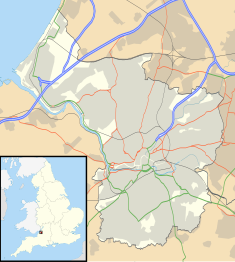Brislington House
| Brislington House | |||||||||||||||||||||||||||||||||||||||||||||||||||||||||||||||||||
|---|---|---|---|---|---|---|---|---|---|---|---|---|---|---|---|---|---|---|---|---|---|---|---|---|---|---|---|---|---|---|---|---|---|---|---|---|---|---|---|---|---|---|---|---|---|---|---|---|---|---|---|---|---|---|---|---|---|---|---|---|---|---|---|---|---|---|---|
| (Long Fox Manor) | |||||||||||||||||||||||||||||||||||||||||||||||||||||||||||||||||||

The front of the central block at Brislington House
|
|||||||||||||||||||||||||||||||||||||||||||||||||||||||||||||||||||
|
|||||||||||||||||||||||||||||||||||||||||||||||||||||||||||||||||||
Brislington House (now known as Long Fox Manor) was built as a private lunatic asylum. When it opened in 1806 it was one of the first purpose-built asylums in England. It is situated on the Bath Road in Brislington, Bristol, although parts of the grounds cross the city boundary into the parish of Keynsham in Bath and North East Somerset.
The Palladian-fronted building was originally seven separate blocks into which patients were allocated depending on their class. The buildings, estate and therapeutic regime designed by Edward Long Fox were based on the principles of moral treatment that was fashionable at the time. Brislington House later influenced the design and construction of other asylums and influenced Acts of Parliament.
The house and ancillary structures are listed buildings that have now been converted into private residences. The original grounds are Grade II* listed on the Register of Historic Parks and Gardens of special historic interest in England and now include St. Brendan's Sixth Form College, sports pitches and some farmland. They are now included on the Heritage at Risk register.
The asylum was established by Edward Long Fox and considered state of the art when it opened in 1806, having been built on moral treatment ideas pioneered at the York Retreat, which had opened in 1796. Fox had an extensive private practice in Bristol and served as a physician at Bristol Infirmary before taking over a madhouse at Cleeve Hill in 1792. He had a range of different businesses locally and was able to pay £4,000 for the Brislington Estate. The site had previously been Brislington Common, which had been enclosed in 1780. The site, on the main road between Bristol and Bath, now the A4, enabled him to attract wealthy clients from both cities.
...
Wikipedia

